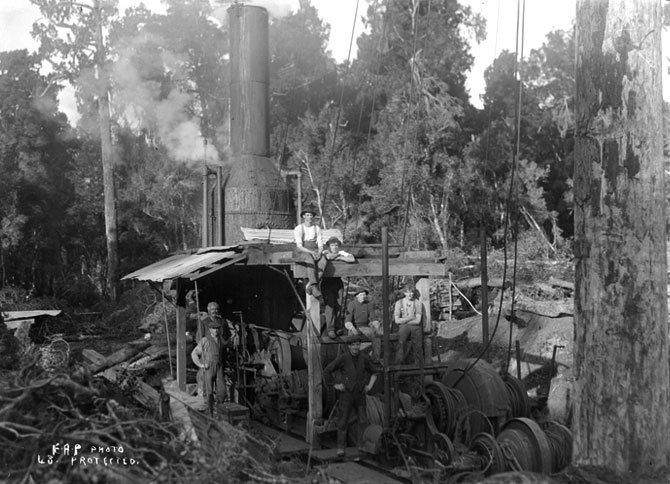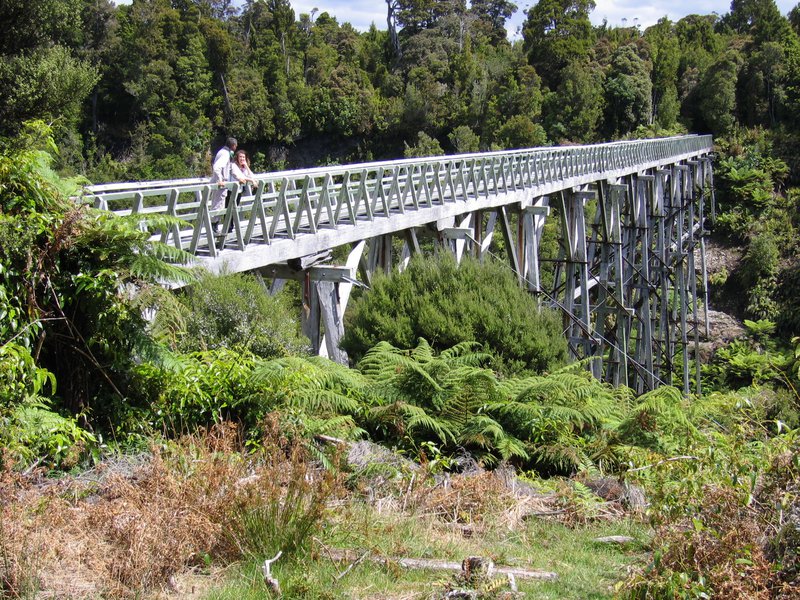Port Craig, in Western Southland, was once the site of the largest sawmilling operation in New Zealand. To transport the timber to the port a tramway and four viaducts were constructed. The largest of the these, the Percy Burn Viaduct, opened in 1925. These impressive structures are now features of the South Coast Track.

The Lidgerwood Log Hauler. Hocken Collections - Uare Taoka o Hākena, University of Otago, S18-175a Lidgerwood Log Hauler, Port Craig, n.d., E.A. Phillips photographer, P1968-001/7-3054.
By 1914, the Marlborough Timber Company’s successful operation in the Marlborough Sounds was nearing completion and the directors of the company were scouting for new forests to mill.
Buoyed by their success in Marlborough, the directors were ready to invest in a larger venture. They secured the milling rights to almost 4,000 acres of bush in coastal Western Southland. Mussel Beach (later renamed Port Craig) was the only suitable port along this area of coastline. This limited accessibility locked out potential competition but would also prove costly for the company.
The building of a road, wharf and breakwater were underway by 1916, and a Lidgerwood overhead log hauler ordered from the United States. The mill began operation in 1921. Nearly 25kms of tramways were constructed, four viaducts built and over 150 men employed. The settlement included a Company store, bakehouse, post office, and schoolhouse.
But this ambitious operation was short-lived. The mill failed to make money, and by October 1928 had no option but to close. The settlement was abandoned, and its inhabitants forced to find work and homes elsewhere.
Infrastructure costs were higher than originally budgeted for, and the forecast output and sales needed to recoup this investment proved unachievable. As the economic depression approached demand for timber dropped, prices were flat, and the high transport costs to bring the product to market from such an isolated location left the company unable to compete with other suppliers.
Some machinery was removed in 1930, the rest left where it lay to be slowly claimed by the bush.

The Percy Burn Viaduct. Photo: John Higham, 2007.
Percy Burn Viaduct
To bring the milled timber along the tramway, four viaducts were built to span deep river valleys. At 125 metres long and 36 metres high, the Percy Burn viaduct is the largest of these four and the largest remaining timber viaduct in New Zealand. Australian hardwood was chosen for its durability; the tall timber piers have concrete footings and the whole structure is reinforced with diagonal and longitudinal steel bracing. The contractors were Invercargill company, Chester Construction Ltd.
For many years, the relics of the Port Craig venture, including its impressive viaducts, were largely forgotten. Percy Burn Viaduct had become structurally unsound and was facing demolition. But a new future for the area was on the horizon.
In 1993, the Port Craig Charitable Trust, with funding and support from the local community, undertook a restoration project of Percy Burn. Rotting or damaged timber, about ten percent of the structure, was replaced with treated Pinus radiata and the viaduct was reopened in April 1994. In 1999, the area became part of the Fiordland National Park. The Department of Conservation (DOC) upgraded the South Coast track, which beyond Port Craig, follows the route of the old tramway. The old school house was restored and converted into accommodation for trampers. The Hump Ridge Track, opened in 2001, added to the popularity of the area.
In 2013, structural safety was again a concern, and the Percy Burn viaduct was closed. Restoration work was led by the Port Craig Viaducts Charitable Trust in partnership with DOC and Southland District Council. The viaduct was reopened in November 2018.
Approximately 4,000 people visit the Percy Burn Viaduct each year.
Heritage recognition
The Percy Burn Viaduct was recognised by Engineering New Zealand as part of the 'Engineering to 1990' project.
The Port Craig Sawmill and Settlement is recognised by Heritage New Zealand as a Category 1 historic place (List no. 9234) www.heritage.org.nz/the-list/details/9234
Find out more
References
Bird, W. Viaducts Against the Sky: The story of Port Craig. Invercargill: Craig Printing, 1998.
Butler, T. 'Port Craig Viaducts Engineering Assessment and Conservation Plan,' 3rd Australasian Engineering Heritage Conference (2009).
Department of Conservation. "Historic Port Craig Sawmill and Settlement Site." www.doc.govt.nz/parks-and-recreation/places-to-go/fiordland/places/fiordland-national-park/heritage-sites/port-craig-sawmill-and-settlement-site
Egerton, R. "Heritage Management at the Port Craig Sawmill Complex: Success and Challenges," 3rd Australasian Engineering Heritage Conference, 2009.
Ministry for Culture and Heritage. "Percy Burn Viaduct." Last modified October 29, 2014. nzhistory.govt.nz/media/photo/percy-burn-viaduct
RNZ National. "Historic Fiordland viaduct reopens." November 30, 2018. www.radionz.co.nz/news/national/377165/heritage-fiordland-viaduct-officially-reopening
Thornton, G. Bridging the Gap: Early bridges in New Zealand, 1830-1939. Auckland: Reed, 2001.
Tuatapere Hump Ridge Track. www.humpridgetrack.co.nz
Access
Port Craig is located 20kms along the South Coast track from the rarakau carpark. For more information please visit www.doc.govt.nz/parks-and-recreation/places-to-go/fiordland/places/fiordland-national-park/things-to-do/tracks/south-coast-track
